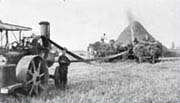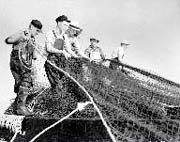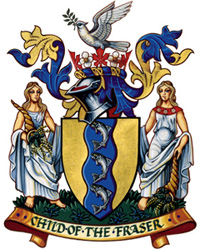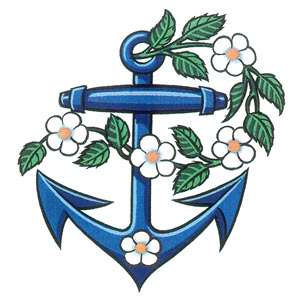Our History
The City of Richmond sits at the mouth of the Fraser River where Indigenous Peoples have been gathering, sharing knowledge and storytelling, and planning for future generations. Indigenous Nations travelled along these waterways, harvesting berries and roots, hunting deer and beaver, fishing for salmon and sturgeon at a place they called sp`’ele k w`e k s (Spall-uk-wicks) — or “Bubbling Water”. Indigenous Peoples were drawn here by the richness of the land and continue to hold important connections to the area.
Richmond was incorporated as a municipality on November 10, 1879 and was designated as a City on December 3, 1990.
 Richmond's islands were built up and shaped by the mighty Fraser River and it is the river that has shaped our growth. The fishery and the rich delta soil provided by the river has been the basis for our economy and industrial development. Richmond's history is rooted in fishing, agriculture, shipping, aviation, and later in manufacturing, service and technological industries.
Richmond's islands were built up and shaped by the mighty Fraser River and it is the river that has shaped our growth. The fishery and the rich delta soil provided by the river has been the basis for our economy and industrial development. Richmond's history is rooted in fishing, agriculture, shipping, aviation, and later in manufacturing, service and technological industries.
The first European settlers to this area were farmers in the 1860s. The pattern of early settlement was oriented to the river, since it was easier to get around by boat than to cross the low-lying, often boggy interior areas of Lulu Island. The Fraser River also provided transport access to Richmond from the nearby City of New Westminster.
 Although the nature of the islands at the mouth of the Fraser suggests they were ideal locations for farms, farming was not easy; clearing, dyking and, in some cases, draining the land was a major task that had to be dealt with before the main work of farming could begin. Once begun, the diversity of agriculture was remarkable. In addition to grain and feed crops, vegetable and berry growing was highly successful. Perhaps the two facets of local agriculture of greatest renown were dairying and berry growing, the latter of which remains important to this day. Two berry crops in particular, blueberries and cranberries, thrive in the more peaty soil of central and eastern Lulu Island.
Although the nature of the islands at the mouth of the Fraser suggests they were ideal locations for farms, farming was not easy; clearing, dyking and, in some cases, draining the land was a major task that had to be dealt with before the main work of farming could begin. Once begun, the diversity of agriculture was remarkable. In addition to grain and feed crops, vegetable and berry growing was highly successful. Perhaps the two facets of local agriculture of greatest renown were dairying and berry growing, the latter of which remains important to this day. Two berry crops in particular, blueberries and cranberries, thrive in the more peaty soil of central and eastern Lulu Island.
The need to build dykes was a significant factor in causing the early settlers to petition the Lieutenant Governor-in-Council to grant status as a municipality to Richmond in 1879. Local government was a necessity if dykes, roads, bridges and other services were to be developed and maintained. This early start means that Richmond is seven years older than our neighbouring city, Vancouver.
The abundance of the fishery attracted many more people to our shores. From the early 1880s Richmond's fishing fleets brought their catches home to be processed in one of the numerous canneries that sprang up all along the river. This industry did more than bring fish to market. Related industries such as boat-building also thrived.
 The vitality of the fishing industry attracted Japanese fishermen to Richmond, adding not just to the industry but to the richness of our community as a whole. The growing cannery and boat building industries brought more migrant workers to the area. Among these were Indigenous people and the Chinese contract workers who originally came to British Columbia to build the railway. Steveston, in particular, became the centre of the fishing industry, gaining international fame for the quality and bounty of its canned salmon. Despite the pressures of changing times, Steveston has survived as a unique, diverse community that maintains strong ties with the sea.
The vitality of the fishing industry attracted Japanese fishermen to Richmond, adding not just to the industry but to the richness of our community as a whole. The growing cannery and boat building industries brought more migrant workers to the area. Among these were Indigenous people and the Chinese contract workers who originally came to British Columbia to build the railway. Steveston, in particular, became the centre of the fishing industry, gaining international fame for the quality and bounty of its canned salmon. Despite the pressures of changing times, Steveston has survived as a unique, diverse community that maintains strong ties with the sea.
Richmond continues to attract in-migration from many other countries and from other parts of Canada with recent migration most notably from China and Hong Kong. Our cultural diversity has enriched our city and made Richmond an exciting place to live.
Richmond is often seen as a new community because it has seen such dramatic growth over the last few decades, but you do not have to look far to see the factors that have shaped our history. The land, the river and the sea made Richmond unique over a century ago, and that is still true today.
Aviation History
Richmond was, and is, the centre of aviation in British Columbia. The first flight in B.C. was made on March 25, 1910, from Minoru Racetrack. The first airport for Vancouver was on Richmond' s Lulu Island. Not much more than a grass field and some small service buildings near what is now Alexandra Road and Garden City Way, the airport remained there until the move to Richmond's Sea Island in 1931.
In recent history the airport has been a major factor in Richmond's ongoing development. Proximity to the airport has helped attract a large number of manufacturing and high technology industries to Richmond. Vancouver International Airport has become an important gateway between Canada and other Pacific Rim countries.
Who or What was Richmond Named For?
Members of the first municipal government did not leave any written confirmation of how Richmond got its name. As a result, it is difficult to conclude that any one person was responsible for the name Richmond.
Research and information from early non-Indigenous settlers in the 1800s have revealed connections with places in Australia, England, and Ontario, Canada. There are four theories as to how the City of Richmond, formerly the municipality of the Township of Richmond (incorporated in 1879) in British Columbia, got its name.
- Hugh McRoberts’ daughter, Jennie, named their Sea Island farm “Richmond View” and the house that was built at the farm “Richmond Place.” The house and farm reminded her of Richmond, New South Wales, Australia, near where she grew up. This was the first time that the name “Richmond” was associated with the place we now call Richmond.
- It was named after the birthplace of Mary Boyd – Richmond, Yorkshire, England. Mary Ann Boyd was the wife of Hugh Boyd who homesteaded on Sea Island in 1866 on a property known as Rosewood Farms.
- William Douglas Ferris drew up the hand-written petition urging the Lieutenant Governor in Council to incorporate the Township of Richmond. There was speculation that he chose Richmond to commemorate the name of his birthplace – Richmond, Surrey, England.
- Descendants of J.W. Sexsmith have indicated that he named Richmond after his birthplace – Richmond Township, Lennox County, (Upper Canada, Canada West) Ontario. Sexsmith was one of the most influential people in Richmond’s early history. He lived and stayed in Richmond and was active in its community and business life.
In 1990 the municipality of the Township of Richmond was designated a City – now the City of Richmond.
To learn more about the naming of Richmond, read the Richmond Archives' blog titled What's in a Name - Richmond.
Coat of Arms
 The predominant colours of the shield and mantle are BLUE and GOLD, the accepted colours for Richmond.
The predominant colours of the shield and mantle are BLUE and GOLD, the accepted colours for Richmond.
The SHIELD is coloured gold, with the wavy pale bar in blue, and three Pacific Salmon thereon in natural colour - silver. The blue bar represents the Fraser River and the delta waters that surround Richmond. The salmon are representative of the most common species that abound in the waters around the municipality. The salmon relate also to the strong historic and continuing association with the fishing industry, responsible for the early prosperity and growth of the community, and very much evident in the present day economy of Richmond.
The CROWN of maple leaves and dogwood flowers relates Richmond to British Columbia and to Canada.
The DOVE rising with the bough in its beak is symbolic of the rising of the land from the water, and relates, of course, to the Bible story of Noah. Richmond was formed from silt deposits and the action of the tides. Also much of it was reclaimed by the early settlers by dyke works. The main islands of Richmond are protected by an adequate system of dyke works, continually being improved and maintained.
The SUPPORTERS represent the goddess FORTUNA, the bearer of prosperity and increase, associated with the bounty of soil and the fruitfulness of women. Fortuna is represented in literature and art as bearing a cornucopia, as the giver of abundance. The sinister supporter (right hand to the viewer) has a robe with a red ribbon around her neck, embroidered with white roses. The red and white are indicative of the colours of Canada and the white roses being in reference to Richmond in Yorkshire which has white roses in its crest. The CORNUCOPIA, held by the supporters is most important to Richmond, in that it has long been the crest of the Municipality and on the official seal of The Corporation. The significance of the CORNUCOPIA is, of course, to the strong agricultural use of the lands of Richmond, a pursuit that brought the first settlers to the area because of the fruitfulness of the rich delta lands. Agriculture plays a great part of in the economy and prosperity of the community and Richmond is well-known for its strawberries, cranberries, potatoes and other produce, and is also known as the blueberry capital of the world.
The green foreground is also representative of the fertile land.
Richmond is indeed a "Child of the Fraser", and the words come from the first line of a poem by Thomas Kidd, a pioneer of the community and one of the signatories to the petition that was presented for the Letters Patent for Richmond.
 The BADGE, represents Richmond's relationship to the fishing industry and the sea, and its agricultural background. The wreath of strawberry leaves and flowers also has some significance in that we understand the strawberry plant is also included or represented in the Coat of Arms of Simon Fraser, after whom the river is named.
The BADGE, represents Richmond's relationship to the fishing industry and the sea, and its agricultural background. The wreath of strawberry leaves and flowers also has some significance in that we understand the strawberry plant is also included or represented in the Coat of Arms of Simon Fraser, after whom the river is named.
Please note: Reproduction or use of this Coat of Arms is not permitted without written permission from the City of Richmond.
Learn more about the history of the City's Visual Identity on the Richmond Archives Blog.
Other Information Sources
To learn more about Richmond's history, visit our Museum, Archives and heritage sites or obtain a copy of "Richmond Child of the Fraser" at our local Library or purchase a copy from the Richmond Archives.To view more historic photos, see Photo Search in the Archives section.
To learn more about historic sites, see the Heritage Inventory and the public Heritage Sites sections.

